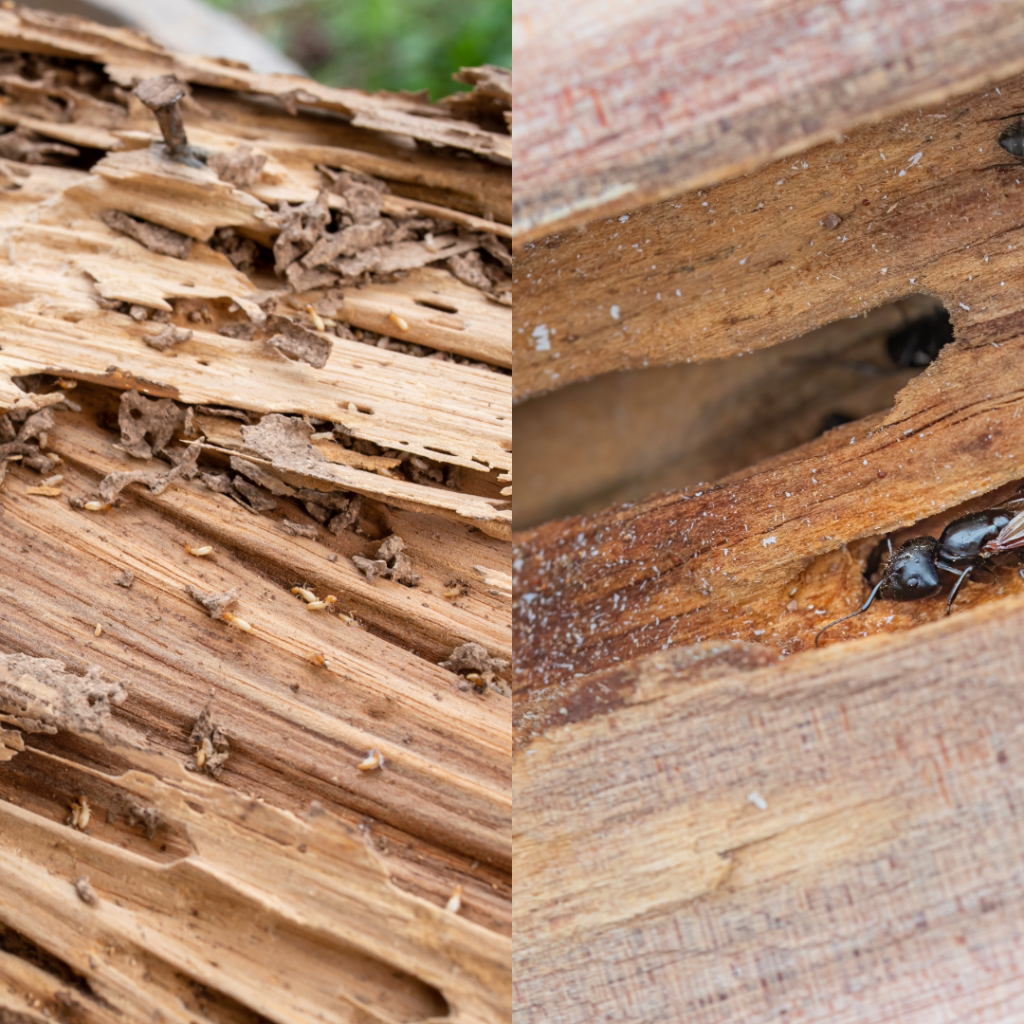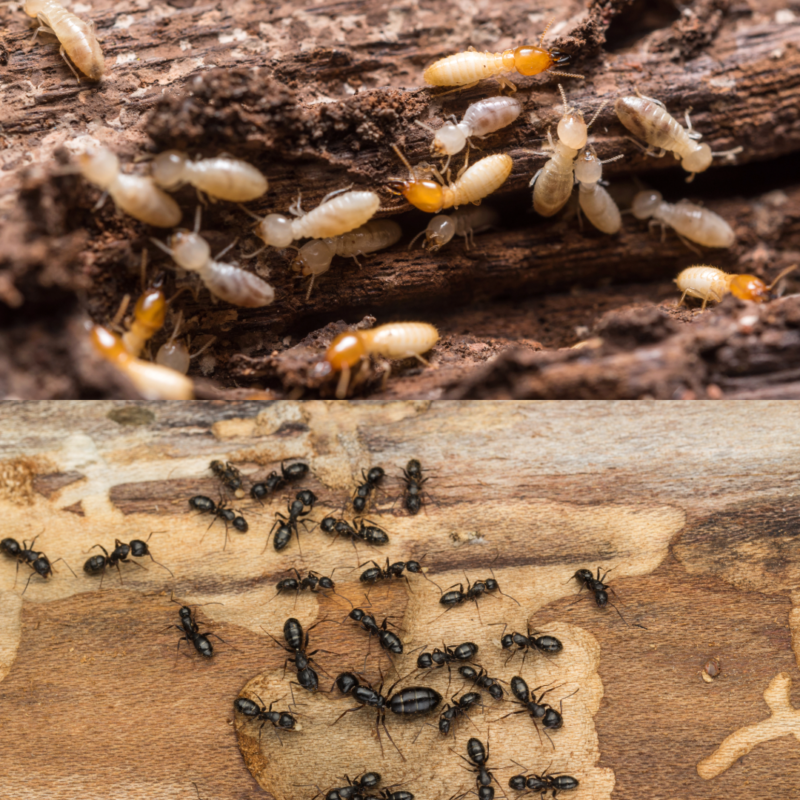Just imagine that, one day, as you’re cleaning your home, you notice some strange wood damage on the windowsill. Upon closer examination, you realize there are some pests at play. This damage didn’t happen all on its own.
Identifying the culprit behind all that chewed-up wood, though, can be challenging. Are they termites or carpenter ants you’re dealing with? That’s the million-dollar question. Both pests spell trouble, but knowing the difference can save you time, money, and perhaps your sanity.
Here’s the thing—knowing which one you’re dealing with doesn’t just make you the Sherlock Holmes of pest detectives (although that’s certainly something to be proud of). It actually helps you in taking swift, appropriate measures before your home becomes a pest’s personal buffet.
That’s where Connor’s Pest Pros comes in, offering targeted expertise to handle both termites and carpenter ants before they take over.
But first, let’s figure out who’s who in this mystery.
Termites or Carpenter Ants: Who Are You Up Against?
Termites and carpenter ants might seem similar at first glance (both are aggravating pests with a penchant for wood), but they’re more like distant cousins than twins.
Termites are the secret nibblers—the ones feasting on wood from the inside out. Carpenter ants, on the other hand, are the lumberjacks of the insect world. They don’t eat wood, but instead, they carve through it to build their homes (although it certainly might look as though they’re eating the wood when you first spot signs of damage).
What does this mean for you? For starters, termites can leave extensive, costly damage that may weaken your home’s structural integrity, while carpenter ants focus more on excavating wood and causing visible cosmetic damage.
Either way, you don’t want either type of pest making themselves at home.
Spotting the Physical Differences

Again, you’ll want to think of termites as the more inconspicuous of the two villains. These tiny, pale pests are often creamy or light brown, with straight, beaded antennae. When it comes to their wings (which they have during their swarming phase), termites have two pairs of equal-length wings.
Meanwhile, carpenter ants are the larger drama queens of the pest world—jet black, red, or a mix of black and red. Their waists are pinched, antennae are bent, and if they’re winged (similar to termites, they swarm in search of mates), their front pair of wings is noticeably longer than the back pair.
Here’s an easy cheat sheet—light color, straight antennae? Termite. Dark color, bent antennae? Carpenter ant.
Where They Attack
Location, location, location. That’s what realtors are all about, but it’s an important distinction to make when you’re trying to figure out whether you’re dealing with termites or carpenter ants, too.
While both pests can give you grief, they have their preferences, much like some of us who lean towards the beach over mountains or vice versa.
Termites love moisture, so you’ll often find them tunneling through damp or rotting wood. Basements, crawl spaces, and areas with water damage? That’s prime real estate for termites. You might also spot mud tubes—those strange, pencil-thin tunnels termites build to travel safely as they munch away.
Carpenter ants, on the other hand, are picky about wood. Typically, they prefer damp or decaying wood, but they can also move into dry wood if the mood strikes.
You’re most likely to encounter their galleries—smooth tunnels inside the wood without mud. If you hear faint rustling sounds at night? That might just be carpenter ants at work inside your walls.
Evidence They Leave Behind

Both termites and carpenter ants are the kind of houseguests who leave a mess.
Termites, the perpetual snackers, leave behind droppings known as “frass.” These droppings resemble tiny wood-colored pellets and are usually found near the damaged wood.
Carpenter ants, being wood sculptors, push out wood shavings as they tunnel. This debris piles up outside their nests, resembling sawdust (and still often referred to as frass).
Whether it’s termites or carpenter ants at work here, spotting either of these signs is your cue to pick up the phone and call a pest expert.
How to Eliminate These Pests
Now that you know who’s who, the next step is eviction.
But here’s the catch—DIY isn’t your friend here. Sure, those termite sprays and ant traps at the hardware store look promising, but they’re band-aid solutions at best. Professionally targeted treatments make sure the problem is handled at the source, which is the key to preventing reinfestation.
Termite treatments often include baiting stations, liquid treatments, or a combination of both to eliminate the colony. Carpenter ants are removed through targeted ant bait, sprays, or dust applications tailored to their nesting behaviors.
But here’s the good news—you don’t need to deal with this alone. Connor’s Pest Pros specializes in identifying and getting rid of both pests with precise, tested methods.
The best part? Our experts don’t just get rid of pests—we help you implement preventive measures to keep them out for good.
Preventing Future Infestations
Once the pests are gone, letting your guard down is the last thing you want to do. Prevention is your new best friend. For termites, focus on reducing moisture around your home.
Repair leaks, ensure proper drainage, and remove wood-to-ground contact (like firewood piles). After all, termites love an all-you-can-eat buffet of damp wood, so don’t give them the satisfaction.
Carpenter ants can be deterred by trimming overhanging branches, sealing cracks and crevices, and repairing water-damaged wood. Regular pest inspections are also important—even the best prevention plans need expert eyes once in a while.
Don’t Wait—Get Professional Help Now
Here’s the bottom line: if you’re seeing signs of wood damage or pests, the best decision you’ll make is calling in the pros.
Connor’s Pest Pros has years of experience helping Northern Virginia and the DC metro area homeowners keep termites and carpenter ants under control. We know the difference, we know their habits, and most importantly, we know how to get rid of them.
Don’t wait for that faint rustling noise to turn into a full-blown infestation—contact Connor’s Pest Pros today. Whether it’s termites or carpenter ants, your home deserves nothing less.



